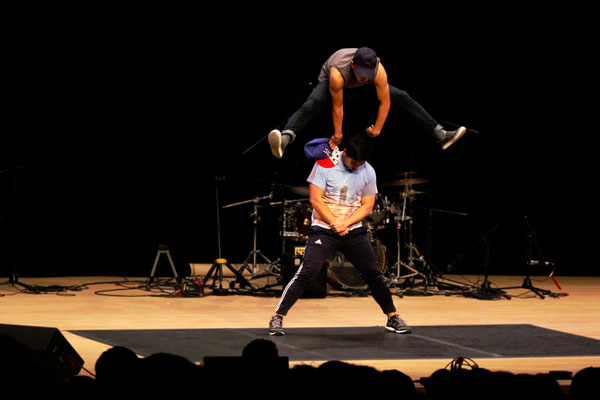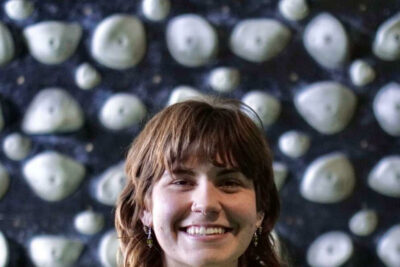Ever since Nimoy Vaidya’s first week as a student at Goshen College, he has searched for others who share his biggest passion in life: b-boying.
Vaidya, now a sophomore, grew up in Kathmandu, Nepal, where he was first exposed to b-boying or break-boying, more widely known as breakdancing, in high school. Boys in his neighborhood practiced this style of dance after school. They had anger and frustration towards the government, explained Vaidya, and they wanted to find some release that was more satisfying and productive than harsh words or violence.Vaidya, too, learned to channel his frustrations through popping, locking, finger-tutting and waving, which are some of the various types of street dances that form b-boying.
“In b-boying there is no one right way of doing a move,” said Vaidya. “Originality is respected above all else.”
Vaidya began using his original dance moves while searching for others to share them with. Vaidya chuckled and said, “I didn’t even care what classes I was taking. I just wanted to get a group of people and start dancing.”
Initially, he was unsuccessful. He was told, “If you want to sing, then you’re in the right place. If you want to dance, you’re going to have a problem.”
But several students mentioned “Phil from China.” So Vaidya set off on a mission to find him.
While waiting in line to swipe his card for lunch one day, he spotted a young man who appeared to be Chinese and have the build of a b-boy. The two enjoyed their lunch together and exchanged small talk until Vaidya could wait no longer.
“I b-boy. Do you b-boy?” Vaidya said.
Phil Chan, then a junior, responded with excitement, “Oh dude, yeah!” The two rushed to the game room and carried out a mini dance battle to take a measure of each other’s skills. As it happens, they were well matched and the battle ended in a draw.
Not long after deciding to dance as a team with Chan, Vaidya heard about Kick Off. Vaidya said that their first performance did not go well.
“Back then we were like two strangers just trying to put together a routine,” he said. “We didn’t connect very well.”
As the year progressed, Vaidya and Chan became comfortable with each other’s dancing style. They now are more aware of their strengths and can choreograph routines to balance their weaknesses.
“Phil is a powerhouse,” Vaidya said. “The moment you see Phil, he’s spinning. He’s like a human windmill.”
“Nimoy focuses more on flexibility and style,” Chan said.
Vaidya uses his strength to pull off lengthy freezes and complicated hand gestures landing right on the beat. When Vaidya executes a freeze, he suspends his body in the air, only touching the ground with one hand, sometimes for up to 20 seconds.
Vaidya explained that some of the most impressive things that Chan can do, Vaidya can’t, but much of Vaidya’s style can’t be conveyed through Chan’s power moves.
“I can hit all those intricate beats,” Vaidya said, “but to get the crowd hyped, we have to get Phil in.”
As a team, Chan and Vaidya previously had goals to perfect a front flip. They both successfully learned the move, but in the process, Chan tore his ACL last May.
“I practiced at least seven hours of just jumping around and flipping that day,” Chan said. “I got careless and landed on the wrong foot. I heard a huge crack and found out I tore my ACL.”
This set back Chan as a dancer and Vaidya as the duo’s choreographer. Vaidya began imagining that his own right foot was injured when choreographing, to take into account Chan’s inability to use his.
Even with Chan’s injury, the pair was able to prepare a routine for this year’s Kick Off. Not only did they receive a standing ovation from the crowd, but they also pleased the judges and left Sauder Hall that evening with a first-place prize.
“I still can’t believe that we won,” said Vaidya. “This was the best routine that we have choreographed so far, but both of us expected nothing more than cheers from the crowd.”
Vaidya explained that breaking is normally danced as a competition or battle between two people, not a performance for a crowd of 500. B-boys usually generate much of their energy from provocative phrases, gestures or dance moves that their opponents throw out.
In order to produce that same level of energy in Sauder Hall, Vaidya viewed the audience as his opponent.
“Every time they cheer and give off all that energy,” he said, “I feel like I need to give them the same amount of energy, if not more.”
With the momentum of their Kick Off win, Chan and Vaidya opened a breaking club. They meet on Tuesdays and Fridays at 8:00 p.m. on the second floor of the Rec-Fitness Center to help teach basic steps and styles of b-boying, while being open to the requests of attendees.
“We don’t require any experience at all,” Chan said, “just enjoy yourself.”

